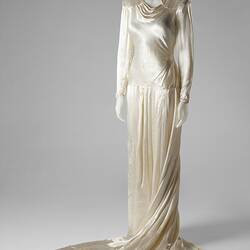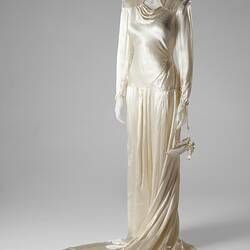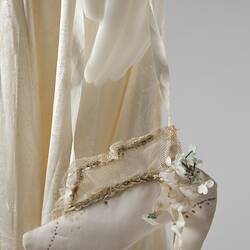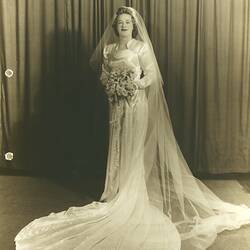Summary
Cream satin wedding dress, full length with train. Floral line pattern printed in matt cream on fabric. Sweetheart neckline with cowl front.
Worn by Elaine Smith at her wedding to ex-serviceman Leo Thomas ('Dick') Colbert on 6 September 1947, at the Presbyterian Church on the corner of New Street and North Road, Brighton.
Elaine designed the dress herself. She had designed many dresses in the past, and generally made her own. (During the War, she often used curtain fabrics due to rationing.) This time she asked her mother's dressmaker to make the dress, with fabric Elaine bought with clothing coupons from Georges. She was pleased at the way the dropped waist and fitted shoulders flattered her shape. Years later, a neighbour remembered how beautiful the dress was. Elaine wore it with a full-length veil, which she later sent to England, to the sister-in-law of a naval officer who had once showed her around a midget sub.
Elaine and Dick were married for 60 years and had three sons. Dick passed away in 2007.
Physical Description
Cream satin wedding dress, full length with train. Floral line pattern printed in matt cream on fabric. Sweetheart neckline with cowl front. Bodice gathered slightly to left waist. Front seam curves into dropped waist. Unlined. buttoned down back with 44 fabric-covered buttons and loops (not holes); 6 similar buttons on each cuff. Pleated at back to form bustle; elongated at back to form lengthy train. Unlined; simply constructed with pinked seams. Surface now has extensive foxing.
Significance
Statement of Significance:
One of several items documenting a post-war Melbourne wedding. The items encapsulate the events and traditions of the time: the dress was made from fabric purchased with coupons from Georges (war-time rationing of clothing was gazetted on 12 June 1942 and removed on 24 June 1948); it was made by the bride's mother's dressmaker; and it was designed by the bride, who had been frustrated in her desire to become a nurse by her father, and instead was studying architectural drafting at night school, and hence had good drawing skills. The dress is made of cream satin, a variation of the white wedding dress that was by then an established Western tradition. The bride's middle class status is reflected in the fact that she was able to have a dress made to wear only at her wedding, and not afterwards, as was often the case during war-time; and by her selection of the exclusive women's clothing shop Georges as the source of her fabric (she also bought her going-away dress there, ready-made). The generous quantity of fabric in her veil also highlights the value of the bridal outfit, as does the fact that she later sent the veil to England, to by worn by the sister-in-law of a naval officer, who was living in England in straitened circumstances.
The dress is accompanied by a simple charm in the shape of a shoe, given to the bride by her cousin, and worn over the bride's arm in the church - the Presbyterian Church, on the corner of New Street and North Road, Brighton. The charm reflects the remnants of folk practice. Popular tradition gives the shoe symbolic importance since Anglo-Saxon times, variously as a symbol of the transfer of 'ownership' of the bride from father to husband (father removing shoe from bride to give to husband), for tossing to members of the wedding party who hoped to marry, or for bestowing luck on the bridal couple (for instance, the 1902 Army and Navy Stores catalogue has 'midget' silver shoes inscribed 'GOOD LUCK', and white satin 'paper slippers' to contain confetti, ices or confectionery).
The bouquet carried by the bride was another important accessory, meaningful on several levels. The flowers were both decorative and symbolic, referring to the fertility of the union; and the fact that they came from her mother's garden provided a personal link back to family and her mother's role in that family.
The significance of this collection is further enhanced by the comprehensive story provided by the bride, who donated the dress and accessories. She tells of settlement on a poultry farm in Clayton obtained by her husband as an ex-serviceman, of their struggle to make a life there, and of their eventual decision to move to Mornington to raise their family, with her husband working as a public servant. The story also links to the story of her father, who kept meticulous account books documenting the expenditure of his family for over 40 years, also donated to Museum Victoria.
More Information
-
Collecting Areas
-
Acquisition Information
Donation from Mrs Elaine H. Colbert, 01 May 2008
-
User
Mrs Elaine Colbert nee Smith, Brighton, Greater Melbourne, Victoria, Australia, 6 Sep 1947
-
Classification
-
Category
-
Discipline
-
Type of item
-
Overall Dimensions
2450 mm (Length), 395 mm (Width)
Across shoulders: 395; neck to front hem: 1415; neck to rear hem: 2450
-
References
'Wartime Weddings! Fashions on the Front, Helen Catriona, 3 Mar 2019, [Link 1] accessed 29 Jun 2021.
-
Keywords
Dressmaking, Marriage Customs & Rites, Wedding Costumes, Weddings, Women's Clothing, World War II, 1939-1945






